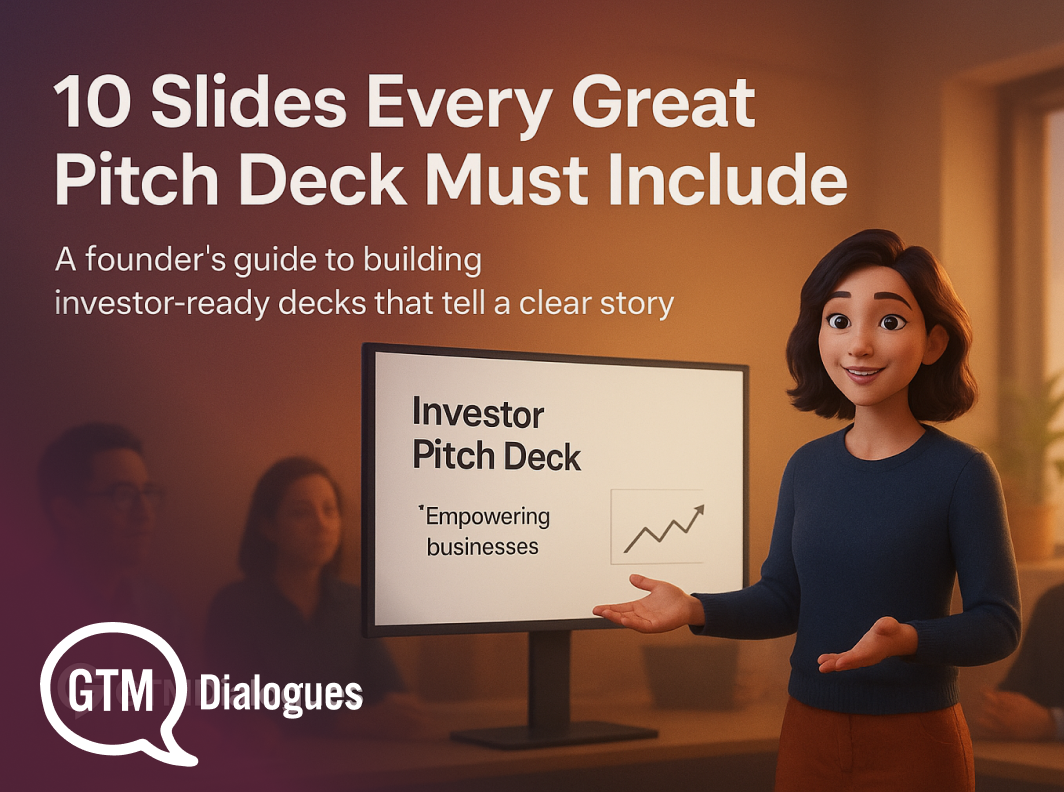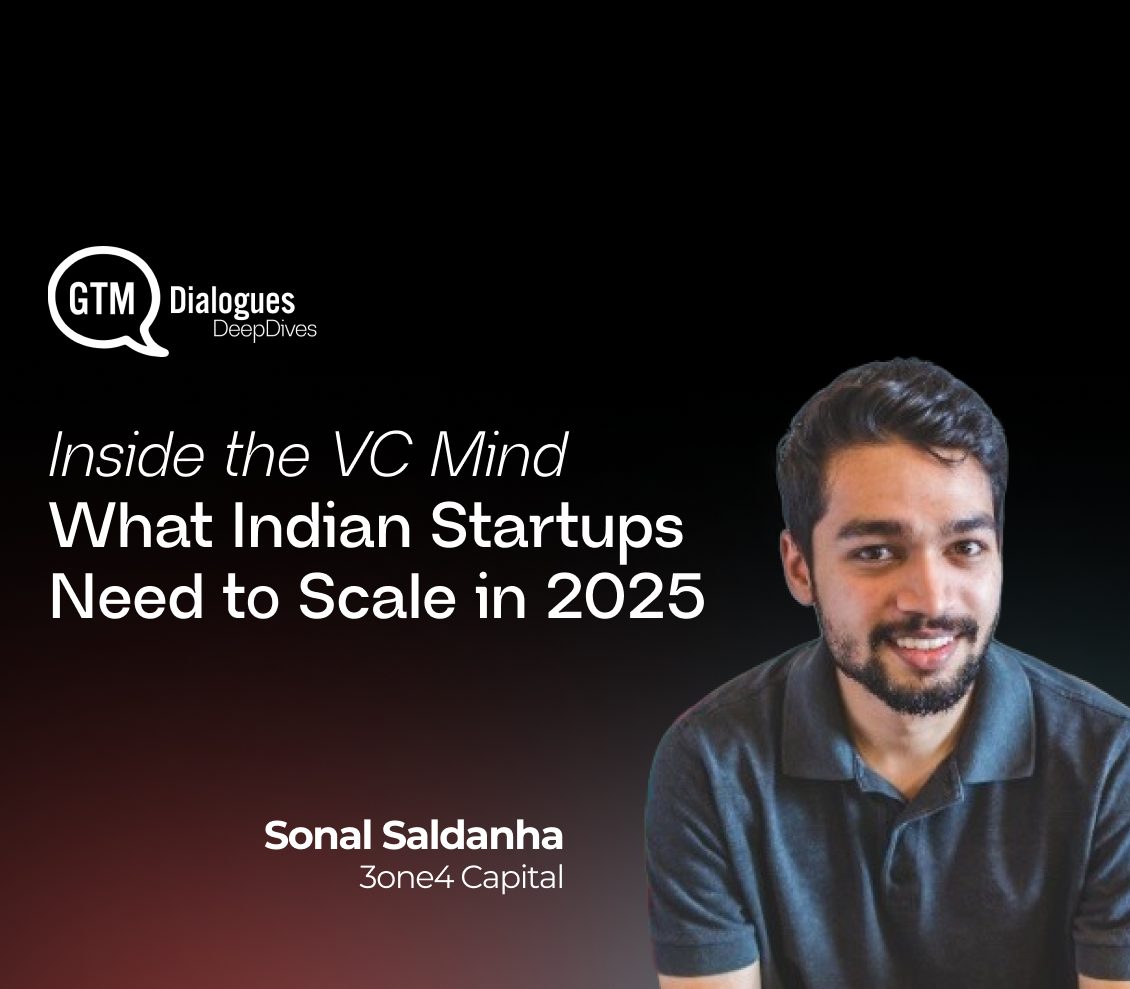If you’re building in 2025, you already know the rules have changed. Raising capital feels slower, sales cycles drag longer, and even the best products struggle to stand out.
You’re not alone in feeling this pressure. In a recent AMA hosted by GTMDialogues, Sonal from 3one4 Capital put it bluntly: “Success isn’t just about building the best product, but about ensuring the right strategy takes it to the people who need it.”
That’s the heart of the challenge today. It’s no longer just about building; it’s about proving you can win in crowded markets, adapt quickly, and execute where others stall.
In this blog, you’ll find what VCs are really looking for in 2025:
- How to use AI as more than a buzzword.
- What early-stage investors actually evaluate when data is thin.
- When to scale in India first, and when to go global from day one.
- Why distribution and GTM execution matter as much as the product itself.
- How to build trust with both investors and enterprise customers.
These are direct takeaways from a VC who has backed companies through India’s toughest markets. Think of it as a playbook you can use right now to raise smarter and scale faster.
How VCs look at AI and product innovation
AI may feel like the hottest ticket right now, but building with AI isn’t enough. Investors are looking for more than just an “AI-first” tag. Sonal explained it clearly: “It’s still hard enough to know what to build and build the right thing.”
Here’s what that means for you as a founder:
- Pick the right problems. AI gives you endless possibilities, but the only ones that matter are those customers will pay for. If your product doesn’t solve a real problem, it won’t stick.
- Be vertical, not just horizontal. Sonal pointed out that while massive horizontals exist, domain-specific applications often win because they deliver predictable, high-quality results every time.
- Don’t chase infra unless it adds control. Infrastructure plays a shift quickly with every new release from big model companies. The edge usually lies in application-layer products that own the customer experience.
- Focus on distribution early. As Sonal explained that the success is not often determined by the product; it has more to do with the distribution. That means investing in GTM from day one, not as an afterthought.
Sonal mentioned how some AI startups succeed by narrowing in on specific use cases like contact center automation or medical copilots.
These verticals give them an advantage because they understand the domain deeply and can build products that work consistently.
What investors really evaluate at the early stage
At the earliest stages, data is scarce. You may not have revenue, and sometimes not even a finished product. That’s why investors lean heavily on the team and its conviction.
Sonal put it directly: “Confidence in the founding team and their unfair advantage is key to bending the odds in their favor.”
What this translates to in your context is:
- Show grit and motivation: Investors want to know if you’ll push through setbacks.
- Highlight your unfair advantage: It could be domain knowledge, customer access, or technical depth, but you need to explain why you’re the right team.
- Bring evidence, not guesses: Even without traction, solid research on market size, competition, and buyer needs proves you’ve done the work.
When 3one4Capital backed Darwin Box, the founders already had a near-complete HRMS product. They weren’t raising to start building, instead they were raising to scale. That readiness made the decision easier.
The takeaway is simple: you can’t control market timing, but you can control how prepared you are. The more clarity you show on the problem, the competition, and your roadmap, the more confidence you inspire in a VC.
India vs. Global – Where should you scale first?
One of the toughest calls you’ll make is deciding whether to scale in India first or go global from day one. The answer depends on your category.
Sonal explained it this way: “Saying let’s go global on day one is not the right way to look at the market. Every region is different and you have to go region by region.”
Here’s how to think about it:
- Go local first when markets are regulated. In sectors like HR or financial services, you need to solve region-specific rules and workflows before scaling abroad.
- Think global when the use case is universal. Products like CRMs or sales tools can adapt with small changes in pricing, integrations, or language.
- Don’t box yourself in. Even if you start in India, design your product and pricing to be global-ready from day one.
Sonal noted that in financial software, founders often need to adapt region by region for compliance. But in categories like CRM, teams can expand faster with minor tweaks and tap global demand early.
Know whether your market is large enough locally, and be honest about how quickly you can adapt internationally. The best products are built flexible enough to thrive in both arenas.
The real challenge – Distribution and Go-to-Market
Several startups in the AMA audience admitted they had strong products but struggled to close deals. Sales cycles dragged, competition caught up, and growth stalled. Their problem wasn’t the product in itself, it was distribution.
Sonal put it simply: “Even the best product doesn’t win if you don’t have the right distribution channels and go-to-market strategy.”
Here’s what you need to focus on:
- Category timing matters: If you’re in the right category at the right time, adoption can compound quickly.
- Clarity beats complexity: Customers respond to simple, sharp positioning that makes them curious enough to try.
- Repeatability is the goal: Build GTM engines; partners, channels, or geographies that can scale without reinventing the wheel every time.
- Beware of inflated metrics: Sonal warned that tactics like prepaid credits may look like fast ARR growth but often hide weak retention.
The real differentiator in 2025 is execution. Your product opens the door, but it’s your go-to-market engine that keeps it open and lets you scale fast.
How to Win Trust with Both Investors and Enterprise Customers
A founder asked Sonal how best to reach his fund. The answer wasn’t about warm intros or personal networks. It was about preparation.
Sonal was clear: “The best way to approach us is through well-prepared emails outlining your key differentiators and traction.” In other words, if you want an investor’s attention, bring substance, not just a story.
The same applies when selling to enterprises. Trust is built in small steps, not one-off pitches. So:
- Show alignment with goals. Prove how your product supports their business priorities.
- Offer ongoing support. Adoption doesn’t stop at sign-up; regular training and check-ins matter.
- Be transparent. Clear expectations reduce friction and build credibility over time.
- Communicate consistently. Investors and customers don’t like surprises, instead regular updates keep your trust intact.
- Respect their process. Whether it’s due diligence or enterprise procurement, follow timelines and share what’s asked for.
- Demonstrate reliability. Small things, on-time responses, clean documentation, clear pricing. Signal whether you can be trusted with bigger commitments.
With both investors and customers, your real advantage comes from consistency. As Sonal reminded, “Creating genuine partnerships rather than transactional interactions helps startups build credibility and sustain growth.”
Practical playbooks you can apply today
Advice is easy to find; execution isn’t. Here are the playbooks you can actually put to work starting today:
- Know your market inside out. Go beyond TAM slides. Map real buyer workflows, talk to end-users, and understand how decisions are made. The sharper your insight, the stronger your edge when pitching.
- Validate pain points early. Run pilots, gather usage data, and get customer quotes. These proof points show VCs you’re solving a problem that’s real, urgent, and worth paying for.
- Build defensible features. Don’t settle for a “me-too” product. Depth in workflows, strong integrations, and superior UX make your product harder to replace and easier to retain.
- Treat GTM as core, not support. Start building repeatable sales motions early whether through partners, outbound, or freemium. A product without distribution is just shelfware.
- Think global-ready. Even if you launch in India, design with international buyers in mind. Currency, compliance, and integrations can’t be afterthoughts if you want to expand later.
- Be transparent with stakeholders. Investors and enterprises respect founders who communicate honestly. Share both wins and setbacks; it builds credibility and long-term trust.
Each of these looks simple, but founders who master them move faster. As Sonal said, “If you can show clarity on the problem, competition, and your roadmap, you will inspire confidence.”
Questions from Founders during the session
How long does early-stage funding usually take?
“It can take a few weeks if everything is clear, but often stretches to months depending on diligence and alignment.”
What Sonal meant was this: if you show up with a clean story, financials in order, customer proof, and a clear roadmap, then things can move quickly. But the moment there are gaps, investors slow down. Think of it like dating! if you’re transparent and prepared, trust builds fast; if not, the process drags.
How does Sonal at 3one4 Capital handle portfolio conflicts?
“It’s not always a deal-breaker. If the companies solve different problems or target different segments, we can back both.”
Founders often panic when they see a competitor in a VC’s portfolio. But Sonal reminded everyone: markets are rarely winner-take-all. What matters is how you position yourself. If you can clearly say, “Here’s who we serve and why it’s different,” then you’ll stand on your own ground.
For startups, when is the right time to expand to the US?
“Don’t go just because it looks like the next big step. Go when your product has repeatability and you’re ready to support customers region by region.”
Too many founders treat the US like a badge of honor. Sonal’s advice was simple: prove you can sell without handholding at home first. When you have repeatability in sales, you can win again and again without rewriting the playbook, you’ll be ready to take that model abroad.
Is it okay for a startup to mix services (training and integrations ) with SaaS product revenue in the early stages?
“It’s okay at the start, but move towards product-led margins quickly. Services don’t scale the same way.”
Sonal wasn’t dismissing services, they can be useful to fund early product development and get you closer to customer pain points. But if most of your revenue comes from services, it’s a red flag. Services say “manual effort,” products say “scalable growth.” Investors want to see you tilt toward the latter.
What’s the best way to reach 3one4capital?
“Through well-prepared emails outlining your differentiators and traction. Warm intros aren’t the only way in.”
This was refreshing. Founders often feel locked out without networks. But Sonal made it clear: a thoughtful email beats a half-hearted intro. If you can show what makes you unique, why the timing is right, and back it with real traction, even a cold email can open doors.






